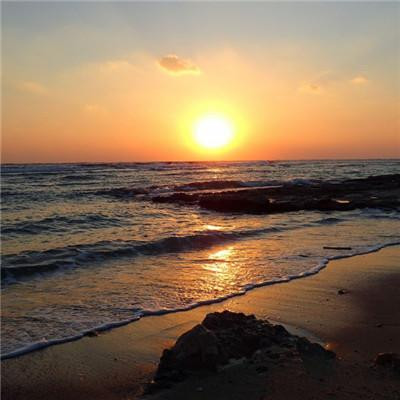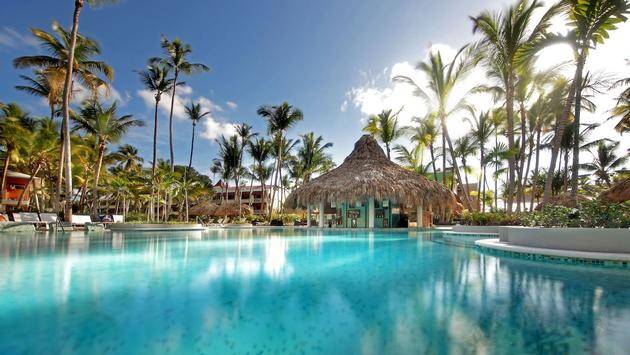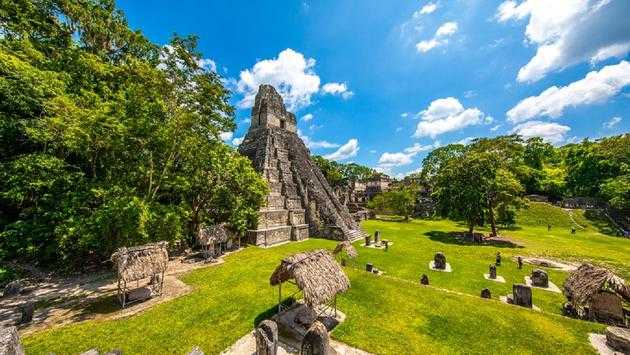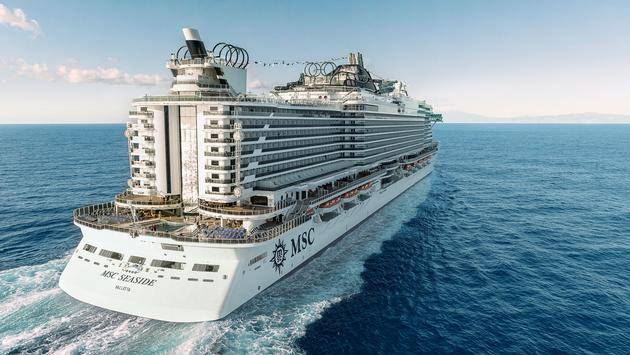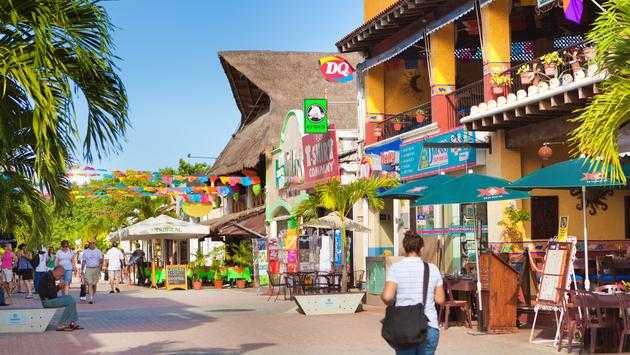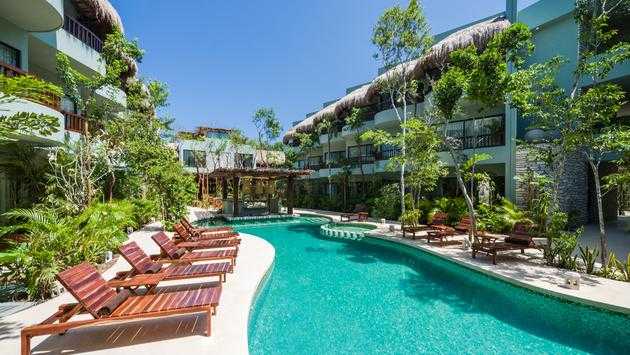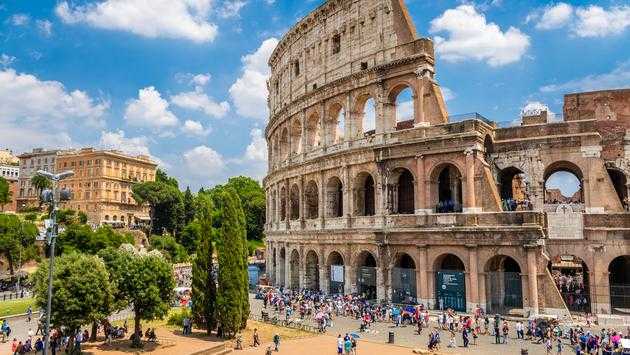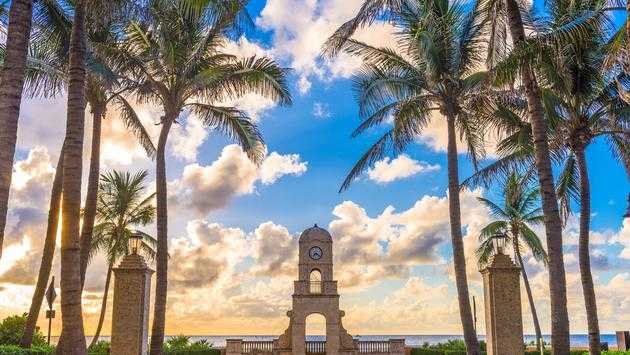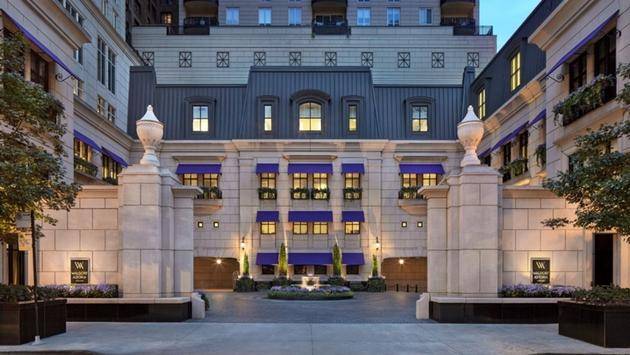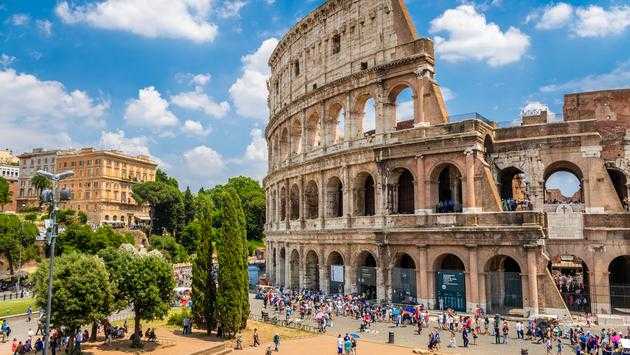A 17 day tour of Mount Emei, Shangri La, Xishuangbanna and Kunming
Recommended accommodation
Xishuangbanna in shuiyifang Boutique Hotel ¥ 456, book now >
Shangri-la Hotel ¥ Book now > 991
Tiger Leaping Gorge Hotel Lijiang ¥ 153, book now >
Launch more hotels
Published on October 22, 2020 13:16
The destination of travel in 2020 is Yunnan. Due to the constant obsession with Chengdu's food and the convenience from Chengdu to Yunnan, the original plan for this year's travel is to start from Chengdu. But in early 2020, the sudden COVID-19 brought great uncertainty to the trip this year, so it has not been able to decide whether to travel or not. I've been at home for more than half a year, and I'm depressed during the epidemic, so I want to go out for air. So I reserved the train ticket and hotel to Qingdao, and went to Qingdao near Tianjin to blow the sea breeze. Two days before the trip, I saw that the epidemic situation in China was relatively stable and I could travel for a long distance. Finally, I decided to go to Qingdao first, and then to Mount Emei in Chengdu and Yunnan.
The total cost of Emeishan and Yunnan (2 persons) is 19723.25 yuan, including:
RMB 6567.42 for transportation, RMB 3776.60 for accommodation, RMB 2862.00 for tickets (including sightseeing buses and Cableways in scenic spots), RMB 6517.23 for shopping, meals, city fares and miscellaneous expenses.
D1
Due to the late arrival of the plane, it's almost 2 p.m. at Chengdu Shuangliu Airport. After picking up the checked luggage, we can't catch up with the high-speed railway from Shuangliu Airport to Emeishan. We have to wait for the 6 o'clock high-speed railway at the high-speed railway station. It's more than 7 o'clock when we arrived at Emeishan high-speed railway station. Fortunately, Emeishan City is not big, so the hotel owner came to pick us up on time.
After settling down in the hotel, we went out for dinner. Emei Mountain is very close to Leshan, and many Leshan delicacies can be eaten here. Because we were going to stay at Jinding of Mt. Emei for one night, we first purchased some food we needed to go up the mountain tomorrow. Later, we found that there were a lot of people eating in a restaurant called niumantang Qiaojiao beef, so we decided to start the first meal of Mt. Emei here.
We ordered a medium portion of haunchy beef and served it with a basin full of beef, miscellaneous beef and vegetables. Beef and beef offal are very tender, beef soup is also very delicious, and rice soaked in soup tastes better.
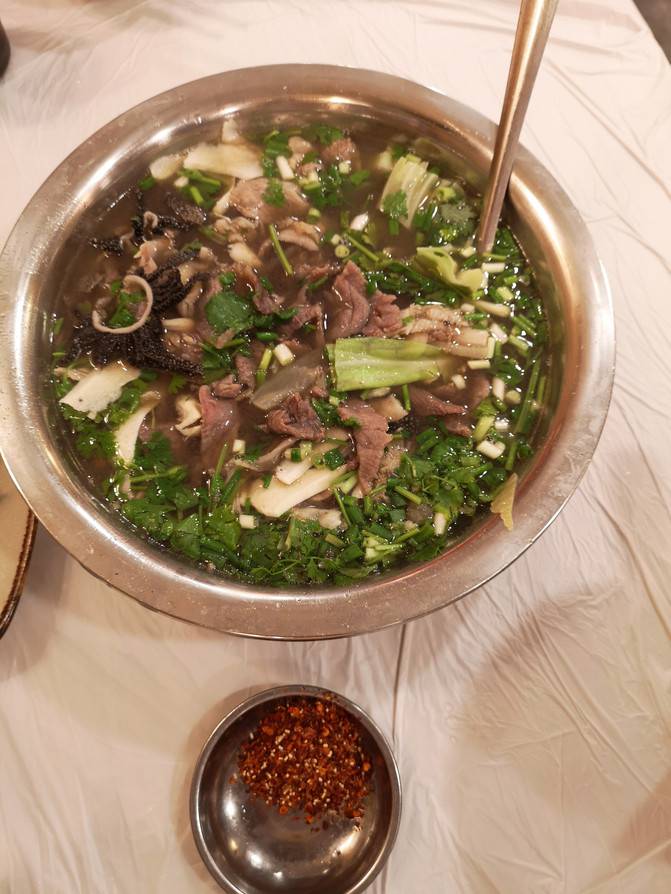
After eating enough beef, go back to the hotel to have a rest and prepare for tomorrow's trip to Mount Emei.
D2
Last night, I found a shop selling Emeishan bean curd with a plaque of "intangible cultural heritage" on the plaque. This morning, I'd like to taste Emeishan bean curd to see what's different from our northern bean curd.
The bean curd here is filled with crispy meat and lots of fried food. It's a little greasy and I'm not used to it.
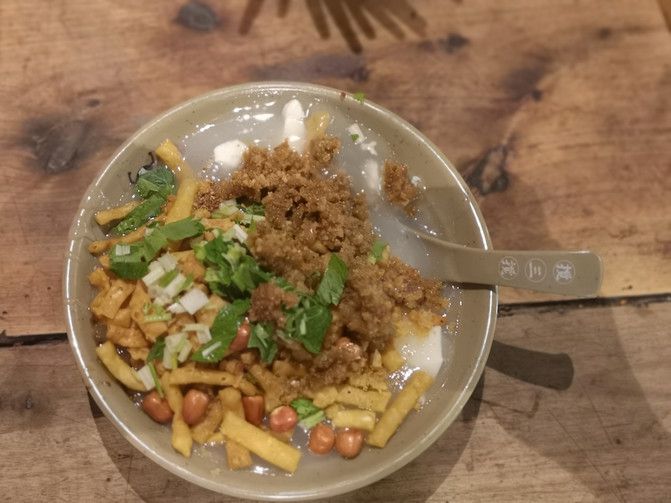
Emeishan bean curd
After breakfast and checking our luggage, we started our journey to Mount Emei.
Mt. Emei is the Taoist temple of Puxian Bodhisattva and one of the "four famous Buddhist mountains" in China. With steep terrain and beautiful scenery, Mt. Emei is known as "the beauty of Emei". The religious culture, especially the Buddhist culture, constitutes the main body of the historical culture of Mount Emei. All the buildings, statues, magic weapons, rituals, music and paintings show the rich flavor of religious culture.
We first came to the Fuhu temple at the foot of the mountain by car.
Fuhu temple, also known as Fuhu temple, Shenlong hall and Huxi jingshe, is adjacent to Baoguo temple. The Ming Dynasty was destroyed and rebuilt in the eighth year of Shunzhi in the Qing Dynasty. It was renamed "Huxi jingshe". Later, because of the tiger trouble nearby, the monks built Zunsheng building to suppress it and renamed "Fuhu Temple". Emperor Kangxi once inscribed "lichui garden" for Fuhu temple.
Entering the temple gate, the eyes are full of green and lush. There are not many people here. The quiet environment makes people feel free from worldliness. Along the stone steps, through xijinlin, the temple with the plaque of "Huxi jingshe" is in front of us.
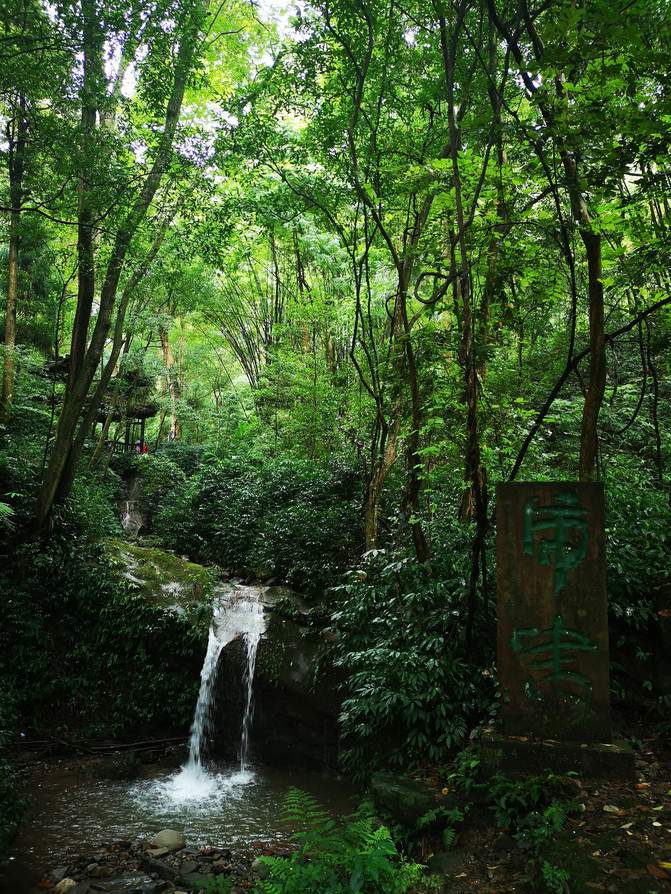
Fuhu Temple
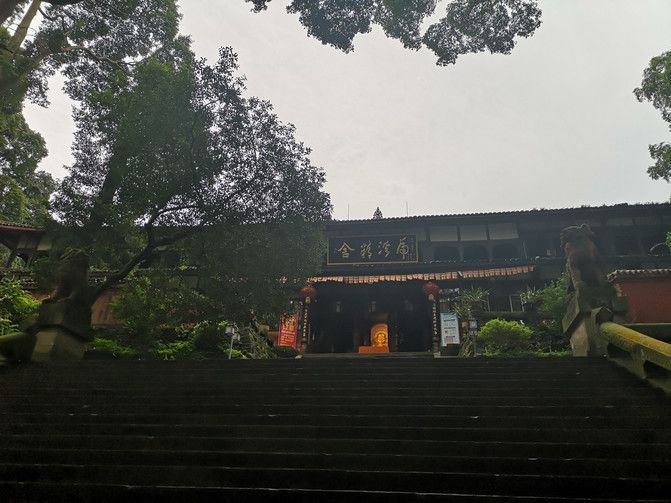
Fuhu Temple
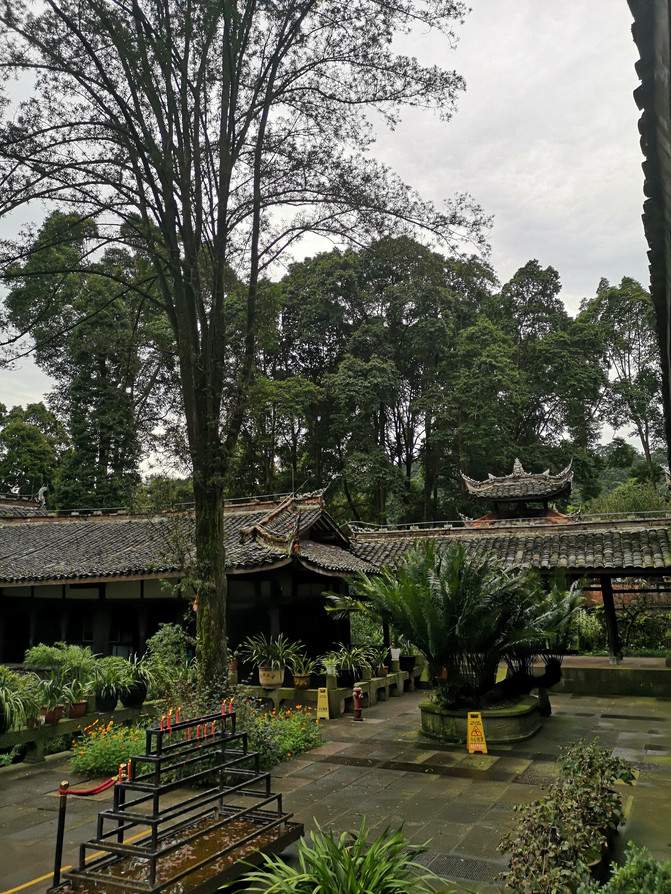
Fuhu Temple
Fuhu Temple
In the Huayan pagoda Pavilion in the backyard on the right side of the main hall, there is a red copper Huayan pagoda cast in the Ming Dynasty. The tower is 5.8 meters high and has 14 floors. There are more than 4700 small Buddha statues on the body of the pagoda. The full text of Huayan Sutra is engraved on the body of the pagoda. Huayan copper pagoda is the most famous copper Pagoda in China for its long history, high shape and excellent casting.
Fuhu Temple Huayan pagoda
Fuhu Temple Huayan pagoda Pavilion
Come out from Fuhu temple, walk slowly along the mountain path, and soon you arrive at Baoguo temple.
Emeishan Baoguo temple is the first temple in Emeishan, the seat of Emeishan Buddhist Association, and the center of Emeishan Buddhist activities. There is a pair of stone lions carved in Ming Dynasty in front of the mountain gate. They are vivid and majestic, just like the left and right gatekeepers, guarding the famous mountain temple. In the 42nd year of Kangxi (1703 AD), Emperor Kangxi took the meaning of "serving the country and the Lord's kindness" in the Buddhist scripture "four kindness and four rewards" and inscribed the plaque of "Baoguo Temple".
This is the place where you have to punch in when you come to Mount Emei, so there are a lot of people. It's better to have a quiet Fuhu temple.
Baoguo Temple
Baoguo Temple
Baoguo Temple
It's almost noon since we came out of Baoguo temple. We walk all the way to Baoguo Temple passenger transport center, and are ready to take a bus to Jinding. On the way, we pass a stone corridor and the first Pavilion.
Mount Emei -- Stone Gallery
Mount Emei -- Stone Gallery
Mount Emei -- Stone Gallery
Mount Emei -- the first Pavilion
The Emeishan sightseeing bus from Baoguosi passenger transport center to leidongping parking lot takes 2 hours. From leidongping parking lot, you can walk to the next station of Jinding cableway in the reception hall, take the cableway up the mountain, and those with good physical strength can also walk up the mountain. The mountain road from the reception hall to Jinding is steep. It takes about 1.5 hours to walk. In order to conserve our physical strength, we chose to take the cableway up the mountain. The uphill road from leidongping parking lot to the reception hall is easy to walk, and the scenery is also good. You can stop and walk all the way, take pictures, and get to the next station of Jinding cableway in about half an hour. The car of Jinding cableway is very big. It is similar to the car of a bus. It can accommodate about thirty or forty people. It takes more than 10 minutes to get to the station of Jinding cableway. Our reservation of Jinding hotel is just at the exit of the cableway station.
It's less than 10 minutes from the hotel to Jinding. After putting down our luggage, we set out for Jinding.
The Golden Summit of Mount Emei is the most concentrated place in Mount Emei temples and scenic spots. It is a symbol of Mount Emei. Mount Emei Jinding, also known as Huazang temple, was built in the Tang Dynasty. The roof was covered by tin tiles, and it was also known as "Yinding" in the Yuan Dynasty. In Jinding, you can see the four wonders of Emei: sunrise, sea of clouds, Buddha light and holy lamp.
At the top of Jinding, there is a rare treasure called "Jinding copper hall", which was donated by Zen master Miaofeng to Lu'an, the vassal of Western Shu in 1602. The hall is 8 meters high, 4.8 meters wide and 4.3 meters deep, with double eaves carved on it and embroidered Brown lock windows around it. The whole body is welded with copper pieces. The eaves tiles on the roof are made of gold. Under the sunlight, they are glittering and shining for hundreds of miles, so they are called "Jinding".
We were lucky. It cleared up when we got to Jinding. Before we reached the Golden Summit, we could see the golden statues of the ten sages standing in the sun. Climbing on the high stone steps, the terrain suddenly becomes clear. The standing statues and golden roofs of Puxian are shining against the background of blue sky and white clouds.
Jinding, Mount Emei
Jinding, Mount Emei
Jinding, Mount Emei
Jinding, Mount Emei
When you look around from the Golden Summit, you can have a panoramic view of the surrounding mountains and the top of Ten Thousand Buddhas in the distance.
Wanfo top is the highest peak of Mount Emei, with an altitude of 3099 meters. It is the highest scenic spot and natural ecological protection area among the four famous Buddhist mountains in China, and also the world natural and cultural heritage site with the highest altitude in China.
Unfortunately, the road to the top of Ten Thousand Buddhas has been closed now, so we can only overlook it from the top of Jinding.
The Golden Summit of Mount Emei
At about 5 o'clock, the tour group and the tourists living at the foot of the mountain came down one after another, and the bustling crowd disappeared. We are the only tourists who live at the top of the mountain and are ready to take the sunset. We stayed at the Golden Summit until the sun set before returning to the hotel.
Jinding, Mount Emei
Jinding, Mount Emei
The Golden Summit of Mount Emei -- sunset
Jinding, Mount Emei
D3
In the morning, before dawn, we came to Jinding again. Many people have gathered here, waiting for the sunrise.
When light began to shine on the edge of the day, people began to stir. Gradually, the day became brighter and brighter, and the edge of the white clouds was dyed golden red by the sunlight. At first, the dark red sun only showed a little bit at the edge of the clouds, and slowly more than half of the sun came out. After a while, the red sun leaped out of the clouds. At this time, the surrounding mountains and Jinding were covered with gold by the sun, and the golden statues and Jinding Hall of the ten sages on all sides were bathed in the glow.
The Golden Summit of Mount Emei -- sunrise
Jinding bathed in the rising sun
The Golden Summit of Mount Emei
When the sun came up, we went back to the hotel contentedly. After breakfast, we are going down the mountain. On a viewing platform near the cableway station, we saw the snow capped mountain in the distance. The snow capped mountain top became more and more bright in the sunshine. On the way to leidongping, I also met the monkey of Mount Emei.
The Golden Summit of Mount Emei
Mt. Emei -- meet monkey by chance
We take a car from leidongping parking lot to Wannian Temple parking lot, and take a cableway from here to Wannian temple.
Wannian temple is one of the Eight Temples in Mt. Emei. The temple provides three treasures of Wannian Temple: Buddha's tooth, Beiye Sutra and imperial seal. There are many steles in the temple, the most famous of which is the "first mountain stele" written by the calligrapher Mi Fu of Song Dynasty. The brick hall without beams in the temple is the second Hall of Wannian temple, also known as Puxian hall. Built in the Ming Dynasty, it is made of bricks. There is no one wood, one pillar and one tile. It is magnificent.
Wannian Temple
Wannian Temple
Wannian Temple
Walk down the mountain from Wannian Temple along the stone steps and pass Bailong cave on the way. Bailong cave is also known as Bailong temple. It was founded by biezhuan Zen master in Jiajing period of Ming Dynasty. There are two caves in the back of the temple, the upper and lower Bailong cave. It is said that it is the place where the white lady practices. Hence the name of the temple.
Bailong cave is not big. It takes only ten minutes to go in for a turn. Continue to go down, and soon you will arrive at Qingyin Pavilion.
Qingyin pavilion was named niuxin temple in the Tang Dynasty, and it was changed into woyun Temple by Zen master Huitong of Jiangling in the Tang Dynasty. In the Ming Dynasty, Guangji Chan Master changed the name of the temple to Qingyin Pavilion by taking the word Qingyin from the poem of Zhaoyin written by Zuo Si, a poet of Jin Dynasty. Qingyin pavilion has only one hall dedicated to the three saints of Huayan, with Sakyamuni Buddha in the middle, Manjusri Bodhisattva on the left and Puxian Bodhisattva on the right. There is "jiewang Pavilion" in front of the pavilion. Although Qingyin Pavilion is small, it is surrounded by mountains and water with beautiful scenery. Its overall layout reflects the artistic conception of "nature, harmony between man and nature". It is a model of Buddhist temple garden architecture in China. "Shuangqiao Qingyin", one of the ten scenic spots of Mount Emei, is located here.
Qingyin Pavilion
Qingyin Pavilion
Qingyin Pavilion
It is also a must for tourists to visit Mount Emei. There are many people, which makes the quiet place noisy. We stop here for a while, then take the bus down the mountain to return to Baoguosi passenger transport center.
After picking up the checked luggage at the foot of the mountain, I took the bus to Emeishan high-speed railway station. It was still early, so I immediately changed the ticket for the latest train to Chengdu.
It's time for dinner to settle down in the hotel. I found Yuanji chuanchuanxiang hot pot restaurant on the Internet, which is close to the hotel, and started a delicious journey in Chengdu.
Chengdu chuanchuanxiang hot pot
D4
Today, I'm going to take a rest day in Chengdu and look for Chengdu's delicious snacks.
Early in the morning, I followed the navigation to a shop specializing in Chengdu snacks, called xiaomingtang Dantian Shuishui. I ordered Chengdu's Dandan noodles and other snacks, and they all tasted very good.
Chengdu snacks
The last time we visited Jinli in Chengdu was in the evening. After breakfast, we decided to visit Jinli in the daytime. I saw a peddler selling sugar, oil and fruit on the side of the road. I bought some and tasted it. The taste was OK.
There are still a lot of people in Jinli during the day, but the buildings without lighting show their simple beauty.
Jinli
Jinli
Jinli
Passing by the tea garden of the Three Kingdoms, I happened to catch up with the performance of Sichuan Opera. We are tired of shopping too. We just go in and have a rest. The program is rich in content, including acrobatics, magic, water sleeve performance, etc. the most wonderful of course is the unique skill of Sichuan Opera -- face changing.
Face changing in Sichuan Opera is an important part of the performing arts of Sichuan Opera. It is a special skill used to shape characters in the art of Sichuan Opera. It is a romantic technique to reveal the inner thoughts and feelings of the characters in the play. It is an artistic treasure created and inherited by the artists of Sichuan Opera of all ages. Generally speaking, there are three ways to change face: "wipe face", "blow face" and "pull face". Sichuan Opera puts "face changing" on the stage and makes it a unique art with wonderful skills.
We enjoyed the performance over tea.
Sichuan Opera Performance
Sichuan Opera Performance
Sichuan Opera Performance
After watching the performance, we thought about the Jianyao tea set we saw in Kuanzhai alley last time. This time we wanted to buy a set to take back, so we came to Kuanzhai alley again. But after walking around Kuanzhai alley for a long time, I didn't find the shop, so I had to give up. Seeing many snacks on kuixinglou street not far from Kuanzhai alley on the Internet, I decided to have dinner there.
Kuixinglou street is a short street with restaurants on both sides, but many of them are hot pot shops. I bought egg cake at a roadside stall. It tastes OK. When I saw a shop called tonguejian party Sichuan snack fair with a lot of people, I ordered a few snacks here. I thought that the shops specializing in snacks would have a good taste, but I didn't expect to order a few snacks with a general taste.
D5
Take the plane to Lijiang from Shuangliu Airport in the morning, and arrive at Lijiang Airport after 1.5 hours flight. Book a hotel in Shuhe ancient town. The hotel has pick-up service. The driver has been waiting for us at the airport. It's about an hour's drive from the airport to Shuhe ancient town, and it's noon to the hotel.
In the afternoon, let's take a look at Mufu, which is located in the ancient city of Lijiang. By the way, let's visit the ancient city of Lijiang.
Lijiang ancient city, also known as Dayan ancient city, is one of the two ancient cities in China that successfully applied for world cultural heritage with the whole ancient city. The streets in the ancient city of Lijiang are built near mountains and rivers, paved with red breccia. There are four streets, Mufu, wufenglou, big waterwheel and other scenic spots in the ancient city of Lijiang.
Mufu in the ancient city was originally the Yamen of Mu family, the hereditary chieftain of Lijiang. It was built in the Yuan Dynasty (1271-1368 A.D.) at the eastern foot of Shizi. It was rebuilt in 1998 and then turned into the ancient city museum. Mufu covers an area of 46 mu. There are 162 rooms with a central axis of 369 meters. Sanqing hall, Yuyin building, Guangbi building, Dharma protection hall, wanjuan building, conference hall and Zhongyi square are well arranged from west to East. There are eleven plaques bestowed by emperors, which reflect the rise and fall of the Mu family. The TV series "Mufu Fengyun", which tells the story of Lijiang's Tusi Fengyun, was shot here.
Mufu has a large scale, and its architectural pattern is similar to that of the Forbidden City in Beijing.
Mufu
Mufu
Mufu
Mufu
Mufu
Coming out of Mufu, I strolled along the streets of the ancient city and came to Sifang Street unconsciously.
Sifang street is the center of Lijiang ancient city. It is said that it was built by the Ming Dynasty's Mu chieftain according to the shape of his seal. This is the most important hub on the ancient tea horse road. Since the Ming and Qing Dynasties, merchants from all walks of life have gathered here, and cultures of all ethnic groups have converged here. It is the center of economic and cultural exchanges in Lijiang.
Turn into an alley beside Sifang street. Flowers are blooming on both sides of the street. Along the lane, the end of the lane is the scenic spot that you have to punch in to the ancient city - the water wheel.
Old Town of Lijiang
Old Town of Lijiang
Old Town of Lijiang
The ancient city of Lijiang
Old Town of Lijiang
After visiting the ancient city, it's time for dinner. In a hot pot shop outside the ancient city, I ordered some dishes that I must eat in Lijiang. A pot full of preserved spareribs is served, which tastes good. After two people are full, there are still many left to eat.
Lijiang hot pot with preserved ribs
D6
I have plenty of time today. I'm going to take the bus to the prime of jade scenic spot. Start from the hotel in the morning, take bus 111 at the gate of Shuhe ancient town, then transfer to bus 17 to Yuhu village, get off and walk along the road to the scenic spot.
Yuzhu Qingtian scenic spot is one of the components of Lijiang Yulong Snow Mountain scenic spot, more than ten miles away from the ancient city. Together with Yushui village, Yufeng temple, Dongba Valley, Dongba wanshen garden and Dongba Kingdom, they are called "three jades and three Dongs".
Yuhu is a man-made lake dug by Mu's family before Ming Dynasty. Mu built Summer Palace, Yulong academy and deer farm by the lake. The earliest inhabitants of Yuhu village were the people who protected the palace and raised deer for the king of Naxi.
The cliff beside the jade lake is engraved with the four characters "jade pillar holding heaven", which is the title book of Yang long, the first official magistrate in Lijiang. This stone carving not only describes the magnificence of Lijiang snow mountain, but also becomes a cultural relic directly related to the important historical event of "changing the land to flow". The snow water in Yuhu lake is clear and the water and grass are swaying. When the weather is fine, the blue sky and white clouds set off the tall Yulong Snow peak, which is reflected in the lake. It seems that nature has settled at the bottom of the lake“ "Reflection of Yuhu Lake" is the first of the twelve scenic spots in Yulong Snow Mountain, which was praised by Naxi poets in Ming and Qing Dynasties.
At present, Yuzhu Qingtian scenic area mainly introduces Dongba culture and Naxi traditional folk custom. There are exhibition halls displaying Dongba characters and Naxi folk custom in the scenic area. Few people come here. The green trees are dancing in the scenic area, and the still reflection in the jade lake is like a picture with heavy ink. Unfortunately, it's cloudy today. We can't see the reflection of Yulong Snow Mountain.
Jade pillar Qingtian scenic spot
Jade pillar Qingtian scenic spot
Jade pillar Qingtian scenic spot
Jade pillar Qingtian scenic spot
From the scenic spot, along the path next to the parking lot, you come to a large meadow. The meadow is full of all kinds of wild flowers. At this time, there are only two of us in the whole meadow. We can enjoy the beautiful scenery of nature. Walking through the big meadow is Yuhu village. The roads in the village are all paved with stones, and the houses are built with stones, which are like nature. The village is very big. When I stroll in the village, I come across a house with the sign "Locke's former residence".
Locke is the first foreign scholar who introduced Lijiang national culture to the western world. In 1922, Joseph Locke entered Yunnan, China from the Thai Burmese border as an explorer, writer and photographer of the National Geographic magazine and the Yanqing Institute of Botany, Harvard University. He lived under the Yulong Snow Mountain for 27 years.
Yuhu Village
Yuhu Village
Yuhu Village
Yuhu Village -- Locke's former residence
When we came back from Yuhu village, we wanted to visit Shuhe ancient town, but suddenly it rained heavily, so we had to go back to the hotel to have a rest.
D7
To Lijiang, you must punch in at Yulong Snow Mountain. We are going to Yulong Snow Mountain today.
Yulong Snow Mountain is the main peak of Yunling mountain in Hengduan Mountain system. It is a young limestone fault block fold mountain. The 13 peaks of the whole mountain are arranged longitudinally from south to north. The main peak has steep fans and the highest altitude is 5596 meters. It is covered with snow all the year round. There are temperate marine glaciers in the Eurasian continent closest to the equator. It is the mountain range with the nearest equatorial snow all the year round in the northern hemisphere. Yulong Snow Mountain has developed tourist attractions (spots) mainly include: Glacier Park, Ganhaizi, lanyuegu, yunshanping, Maoniuping, etc. there are three Cableways up the mountain, which are the big cableway to Glacier Park, the middle cableway to Maoniuping and the small cableway to yunshanping.
Due to the overcast weather and thick clouds, we decided to give up the Glacier Park and go to Maoniuping at an altitude of 3700 meters, and then go to the blue moon valley. Vehicles entering the scenic area can only drive to the tourist center in Ganhaizi, and then take the sightseeing bus to the cableway station and take the cableway up the mountain.
Yakniuping is called "Ge Zhan Gu" in NASH language. Ge is an alpine meadow, whose exhibition is like a list of stars. In ancient times, it is a side or a corner, which means that one side is like a mountain meadow listed by stars.
As the cableway passes through the mountains, the fog becomes heavier and heavier. The moment you walk out of the cableway, you will be surrounded by dense fog, and the visibility is very low. As we walked, we patted the flowers and plants with water drops on the meadow, expecting that the thick fog would disperse later.
Yulong Snow Mountain -- Maoniuping
Yulong Snow Mountain -- Maoniuping
Yulong Snow Mountain yakniuping snow Temple
After waiting for more than an hour, the fog still showed no sign of dispersing, so we had to take the cableway down the mountain. We got off at Blue Moon Valley and began to visit it.
The ice and snow on Yulong Snow Mountain melt into river water, passing through the valley from the east foot of the snow mountain. Because the color of the water is blue, and the valley is crescent shaped, it looks like a blue moon inlaid at the foot of Yulong Snow Mountain from a distance. Because the blue moon Valley in the lost horizon written by British writer Hilton is similar to this, it is called "Blue Moon Valley". The river water in Blue Moon Valley is blocked by mountains in the process of flowing, forming four large water surfaces, which are called Yuye lake, Jingtan lake, blue moon lake and Tingtao lake. The lake shore is surrounded by lush vegetation, and the snow peak is set off in the distance.
The lake water of Blue Moon Valley has different shades of blue. The lakeside is connected by a plank road, so people can get close to the water. Maybe it's because the weather is not good today and we can't see the real appearance of the snow mountain. People gather here and there is a lot of people here.
Yulong Snow Mountain -- Blue Moon Valley
Yulong Snow Mountain -- Blue Moon Valley
Yulong Snow Mountain -- Blue Moon Valley
Yulong Snow Mountain -- Blue Moon Valley
Yulong Snow Mountain -- Blue Moon Valley
Yulong Snow Mountain -- Blue Moon Valley
After the blue moon valley tour, today's trip to Yulong Snow Mountain is over. Back from Yulong Snow Mountain, we strolled in Shuhe ancient town.
Shuhe ancient town is one of the earliest settlements of Naxi ancestors in Bazi, Lijiang. It is an important market town well preserved on the ancient tea horse road. It is also a living specimen of Naxi ancestors' transition from agricultural civilization to commercial civilization. It is a model of market town construction formed by opening up and horse gang activities.
Shuhe ancient town
Shuhe ancient town
Shuhe ancient town
Shuhe ancient town
On the edge of the ancient town, I met a small shop that operated local chicken rice noodles. The local chicken rice noodles cost 12 yuan a bowl. The rice noodles are smooth and the chicken soup tastes mellow.
Local chicken rice noodles
D8
There is only road from Lijiang to Shangri La now. In order to visit Tiger Leaping Gorge on the way, we have reserved a carpool from Lijiang to Shangri La online. The car can stay on Tiger Leaping Gorge for one and a half hours.
The Jinsha River, which originates from the snowy mountain of Geladandong in Qinghai Province, flows here for thousands of miles. Suddenly, it is blocked by two snowy mountains, Yulong and Haba. The originally calm and peaceful river water suddenly becomes furious. Here, it runs into the huge gap between Haba snowy mountain and Yulong snowy mountain, and cuts a long and narrow valley, which is the famous Grand Canyon Tiger Leaping Gorge. Tiger Leaping Gorge is the largest gorge in the Yangtze River. It is famous for its danger and magnificence. It is one of the deepest gorges in China. It is named after the legend of tiger leaping across the river. It consists of three sections: up tiger jump, middle tiger jump and down tiger jump, as well as high road hiking line.
Shanghutiao is the narrowest section of the canyon. In the 30 meter wide river, there is a huge stone four or five meters high standing in the middle of the river. It lies across the middle stream like a waterfall. The steep ridge divides the torrent into two and makes the waves shake the sky. It is said that a tiger once jumped from the side of Yulong Snow Mountain to Haba snow mountain by taking advantage of the huge stone in the middle of the river. Therefore, the stone is named Hutiao stone.
The car stops beside the road and goes down the stairs. By the side of the river, you can see a leaping stone tiger statue, with its base about 3 meters high. This is the landmark stone sculpture of entering Tiger Leaping Gorge. From there, you enter the Grand Canyon. On both sides of the canyon, there are high mountains. There are many reefs in the river. The river flows forward under the confrontation of Yulong and Haba snow capped mountains, just like a fierce tiger going down the mountain. The wind blows fast, the water bursts in, the valley roars, and the momentum is extraordinary. The surging river water, with its roar, snowy waves, swirling and misty air, constitutes a rare landscape spectacle in the world.
Tiger Leaping Gorge
Tiger Leaping Gorge
Tiger Leaping Gorge
Tiger Leaping Gorge
Tiger Leaping Gorge
After the tour, we continued to take the bus. The car stops in Xiaozhongdian for a while. There is a sea of flowers here. It was September when the flowers of Stellera chamaejasme were blooming. The red flowers of Stellera chamaejasme, green hills and grass made a beautiful picture.
Shangri la -- Xiaozhongdian -- Stellera chamaejasme
Shangri la -- Xiaozhongdian -- Stellera chamaejasme
At about 2 o'clock, we arrived at the East Gate parking lot of dukezong ancient city in Shangri La.
Dukezong ancient city is an ancient city with a history of more than 1300 years. It is the best preserved and largest Tibetan residential group in China. Dukezong ancient city used to be the hub of the ancient tea horse road, the window of cultural exchanges between Tibetan villages in the snow region and Yunnan region, and the economic and trade link between Sichuan, Tibet and Yunnan region. In 2014, a fire destroyed most of the houses in the ancient city, which was rebuilt later.
The hotel we ordered was at the north gate of the ancient city. We wanted to take a taxi with our luggage, but it was hard to get a taxi in the East Gate parking lot. So we contacted the innkeeper to pick us up.
It's late in the dark in Shangri La. After settling in the inn, we took a taxi to Songzanlin temple, which is not far from the ancient city.
Gadan Songzanlin temple, also known as Guihua temple, is the largest Tibetan Buddhist temple in Yunnan Province. It is also one of the famous large temples in Tibet. It is also the center of yellow religion in Sichuan and Yunnan. It plays an important role in the whole Tibetan area and is known as "little potala palace". The temple is built on the mountain and looks like an old castle. It gathers the essence of Tibetan religious culture and sets the great achievements of Tibetan plastic arts. The building is resplendent and magnificent, with gold-plated copper tiles of rich and colorful shapes, the cornice of Baojiao beast kiss, and the spacious and magnificent ZHACANG hall. There are many Buddha statues in the hall, and the murals on both sides are exquisitely carved, which is also known as the "Tibetan Art Museum".
We first visited the museum opposite the tourist center, which displays many beautiful thangkas, as well as a three-dimensional four sided Mandala, which is very exquisitely constructed.
Beautiful Thangka
Beautiful Thangka
After visiting the museum, take a sightseeing car from the tourist center to Songzanlin temple. When looking for the strategy, we learned that the whole Songzanlin temple can be photographed in the lake of ramyangcuo in front of the temple. After getting off the bus, we made a turn around the artificial footpath of lamyangcuo lake. The lake is clear with abundant water and grass. From time to time, ducklings are playing in the water for food. At the moment when the sun came out of the clouds, we photographed the reflection of Songzanlin temple in the water. The gilded copper tiles on the main hall were shining in the sun.
Lamyangcuo Lake
Lamyangcuo Lake
Lamyangcuo Lake
The ticket of Songzanlin Temple includes explanation. The tour guide will gather the individual visitors and bring them into the temple together to explain as they walk. When we finished the ramyangcuo Lake tour, we just caught up with the guide to bring a group of tourists into the temple, so we followed the guide into Songzanlin temple.
Similar to the architectural style of Tibetan Buddhism, the main halls of ZHACANG and Jikang of Songzanlin temple stand high in the center, surrounded by eight Kangshen and monk's houses. They are high and low, with progressive layers and clear three-dimensional outline, which fully sets off the height and grandeur of the main building. The main building is ZHACANG, which means monastery in Tibetan. It is a place where monks learn classics and study doctrines.
Kadan Songzanlin Temple
Kadan Songzanlin Temple
Kadan Songzanlin Temple
Gadan Songzanlin Temple Tibetan food and yak meat hotpot are the special food of Shangri La. When you come back from Songzanlin temple, you can find a special hot pot shop in shuiyifang that has high online evaluation in the ancient city to eat yak meat hotpot. The shop assistant recommended yak meat and Black Pork platter, wild vegetables platter and highland barley cake. We also wanted to order other things. The shop assistant was afraid that we could not eat them, so he tried to dissuade us. Yak meat and black pork are very tender. There are all kinds of seasonal wild vegetables in the wild vegetables platter. In the end, we were full before we finished eating them.
Shangri la yak meat hot pot
D9
Book a direct through train from dukezong ancient city to Pudacuo National Park, and get on at the parking lot in front of moonlight square in the morning. On the way, I met a vendor selling yak milk products and highland barley cakes, and bought yak milk and highland barley cakes, which were very delicious.
The hill to the east of moonlight square is the famous Guishan Park in Shangri La. Beautiful sunshine, pure blue sky and white clouds, as well as the golden tube constitute the most beautiful picture. There is a large pool at the entrance of the park. It is clear and bright. It is the spring water from the ancient well. The water can be drunk directly. Many people's living water in the city comes from it.
Ancient well at the entrance of Guishan Park
On both sides of the square are the Red Army Long March Museum and Diqing history museum. It's still a while before we get on the bus. Let's go to the Red Army Long March Museum and Diqing History Museum first. In fact, the Red Army Long March museum is also a Tibetan temple, in which there is a main hall, where many local aunts come to pay homage. There are some historical relics on display in Diqing history museum.
Red Army Long March Museum
Red Army Long March Museum
Diqing History Museum
The through train was originally scheduled to leave at 10 o'clock, but due to the staff's fault, it was delayed for some time. It was nearly 12 o'clock when it arrived at the scenic spot.
Pudacuo National Park is located in the center of the "Three Parallel Rivers" World Natural Heritage in Northwest Yunnan, with an altitude of 3500 meters to 4159 meters. It is composed of Bitahai Nature Reserve, an international important wetland, and Duhu scenic spot in Haba area, a "Three Parallel Rivers" world natural heritage. Bitahai, gudu lake and militang subalpine pasture are the main components. It has geological landforms, lakes and wetlands, forest meadows, river valleys and streams, rare animals and plants, and the original ecological environment is well preserved. It is one of the main tourist attractions in Shangri La.
In order to protect a kind of rare fish -- "Schizothorax", militang and Bitahai have been closed, and only Guidu Lake scenic area is open to the public.
In the customer service center, you can take the sightseeing bus of the scenic spot to the gedugang River hiking experience area, from which you need to walk 3 kilometers to the gedu Lake scenic spot. Only a few of the passengers get off here, and the others go directly to the lake. As we have plenty of time, we get off here and go to gudu lake on foot.
It belongs to dugang River hiking experience area. There is a path winding in the high mountain gorge. Because there are not many people here, the damage to the surrounding environment is not great, and the environment here is more original. The virgin forest blocks the sky and the sun, and the canopy is thick green and meticulous, sheltering from wind and rain. Walking through the lush forest, I didn't feel that I was on the plateau with an altitude of more than 3000 meters.
Pudacuo National Park belongs to dugang River hiking experience area
Pudacuo National Park belongs to dugang River hiking experience area
Pudacuo National Park belongs to dugang River hiking experience area
Pudacuo National Park belongs to dugang River hiking experience area
Pudacuo National Park belongs to dugang River hiking experience area
The end of the hiking experience area is the parking lot of Duhu scenic area.
The green hills around the lake are gloomy, and the spruce and fir in the mountains are tall and strong, pointing straight to the clouds. There are many wild birds in the lake, such as wild ducks and yellow ducks.
Along the plank road into the scenic area, a large area of the lake into the eye, shallow water where there is a lush grass. Maybe the sky is gloomy, the scenery here is not as beautiful as you think.
Gudu lake, Pudacuo National Park
Gudu lake, Pudacuo National Park
Gudu lake, Pudacuo National Park
Gudu lake, Pudacuo National Park
Return from Pudacuo National Park at four o'clock, get off at the east gate of dukezong ancient city in an hour, and just go to Guishan park first.
Climbing up the steep steps, you will soon arrive at the Han temple, behind which is the world's largest turning tube. Looking up, the whole warping tube is about five stories high, magnificent. The tube is made of pure copper and gilded. At the top of the tube wall, four Bodhisattvas, Manjusri, Puxian, Guanyin and dizang, are carved in relief. At the bottom of the tube are eight treasures of Buddhism. There are also 1.24 million sutras and many kinds of Buddhist treasures in the tube, with a total weight of about 16 tons. To turn such a huge Sutra tube, more than ten people need to work together. Turn the scripture tube clockwise, and each turn is equivalent to 1.24 million Buddhist Chants. After three turns, you can eliminate disasters and pray for good luck.
Looking down from Guishan Park, you can have a panoramic view of Shangri La city. You can enjoy the smoke curling in the city and the water color of qinglongtan.
Guishan Park
Guishan Park
Guishan Park -- zhuanjing tube
In Guishan Park, we will work together to turn the scripture tube for three weeks, hoping that everything will go well. When I came out of Guishan Park, I wanted to have a Tibetan meal, so I searched in the ancient city and found a small restaurant named Tibetan Xinqiao snack. Ordered barley noodles, fried Tibetan pork slices, hand Zanba and butter tea. Zanba is sweet, butter tea is rich in milk, barley noodles and fried Tibetan pork slices are also delicious.
Dukezong ancient city
Dukezong ancient city
Dukezong ancient city
Hand grasping Zanba and butter tea
Highland barley noodles and fried Tibetan pork slices
After eating and drinking enough, he continued to stroll in the ancient city and entered the old street of Shambhala, an antique street.
Xiangbala old street
Xiangbala old street
Xiangbala old street
Xiangbala old street
Xiangbala old street
I have already reserved a three-day stay in Shangri La. As a result, I feel unwell. So I decided to check out at the Inn and return to Lijiang tomorrow.
D10
I left Shangri La in the morning and arrived in Lijiang at noon. In the afternoon, I decided to go to Heilongtan Park, which is not far from the inn.
There are many buses from the ancient city to Heilongtan Park. There is a crystal clear spring pool in Heilongtan Park. The scattered ancient buildings include Dragon Temple, Deyue tower, suokui bridge, Yuhuang Pavilion, and the extrication forest gate tower and Wufeng tower of Fuguo temple in Zhishan of Ming Dynasty.
When the weather is fine, you can take pictures of Yulong Snow Mountain reflected in the black dragon pool. The clouds are very thick these days. We can't see the snow mountain at all.
Heilongtan Park
Heilongtan Park
Heilongtan Park
Heilongtan Park
Lijiang ancient city is about one kilometer away from Heilongtan Park and along Yuhe river. See a lot of strategies are recommended 88 snack bar, also want to try. Following the navigation, I came here and ordered four snacks. As a result, I was told that three of them didn't have any, so I decided to get up and look for food elsewhere.
The alternative foraging site is Zhongyi market, which many local people often visit. There is a night market for delicious food after 6 p.m.
D11
Take bus No.6 from the ancient city, and the terminal is yushuizhai scenic spot.
Yushuizhai scenic spot is located at the foot of Yulong Snow Mountain. It is the holy land of Lijiang Dongba culture inheritance, Baisha Xile inheritance base and Leba dance inheritance base. Shanzhai, with its natural simplicity, mountains and rivers, and beautiful scenery, is a treasure land of geomantic omen with national cultural characteristics.
When you enter the scenic area, the first thing you see is the World Memory Heritage Dongba ancient books cultural monument. It goes up the mountain road, and the end point is the nature Dharma field, which is the source of Lijiang. There are Dongba temple, folk custom courtyard and other exhibition areas to introduce Dongba culture in the scenic spot, which can deeply understand Dongba culture and Naxi folk custom.
Yushuizhai
Yushuizhai
Yushuizhai
Yushuizhai: Dongba characters
Yushuizhai
Yushuizhai
From yushuizhai out, along the road down about half an hour is Yufeng temple.
Yufeng temple is located at the southern foot of Yulong Snow Mountain, 13 kilometers away from Lijiang ancient city. It was built in 1700, the 39th year of Kangxi reign of Qing Dynasty. It has nine courtyards at its largest scale, including the main hall and the upper and lower courtyards. Yufeng temple in Tibetan Zhaxi qupeilin, which means "auspicious Hongfa garden", is one of the five major Buddhist temples in Lijiang, along with Fuguo temple, Puji temple, Wenfeng temple and Zhiyun temple.
Yufeng Temple
Yufeng Temple
The "ten thousand Camellia" tree of Yufeng temple is famous all over the world. It is the eighth great situ living Buddha of karma Kagyu school. It has been planted by kejijinai himself for nearly 500 years. From the beginning of spring to the beginning of summer, ten thousand camellia trees have been blooming for more than one hundred days. More than twenty thousand camellia flowers vie with each other in more than twenty batches. They are known as "the king of Camellia in the world" and "the first tree in the world".
It's a pity that we missed the flowering period and failed to see ten thousand Camellia blooming.
Yufeng Temple -- "ten thousand Camellia" tree
Yufeng Temple -- "ten thousand Camellia" tree (photo introduction)
From Yufeng Temple out, just in time to catch a back to the ancient city of No. 6 bus. Go back to the inn to pick up your luggage and go to Lijiang Airport to start the journey of Xishuangbanna.
D12
Xishuangbanna is a place where Dai people gather. Due to the late arrival of the plane, we arrived at the hotel of xishuangjing in Gaozhuang, Jinghong, the capital of Xishuangbanna, late yesterday. We didn't see the surrounding environment. Looking out from the balcony of my room this morning, I saw that the garden of the hotel and both sides of the street were full of flowers, and banana trees and tall coconut trees were covered with fruits. Most of the buildings are white, and the style is quite different from that of the mainland, which is very Southeast Asian.
Shuangjing in the west of Gaozhuang is in Dai language, which means "nine towers and twelve villages" in Chinese. Through the overall planning of "one river and two gates, nine towers and twelve villages", it aims to reproduce the prosperous scenery of Jinghong in ancient times, create a prosperous "city in Jinghong City", face the international market and welcome tens of millions of tourists.
Two sceneries in the west of Gaozhuang
